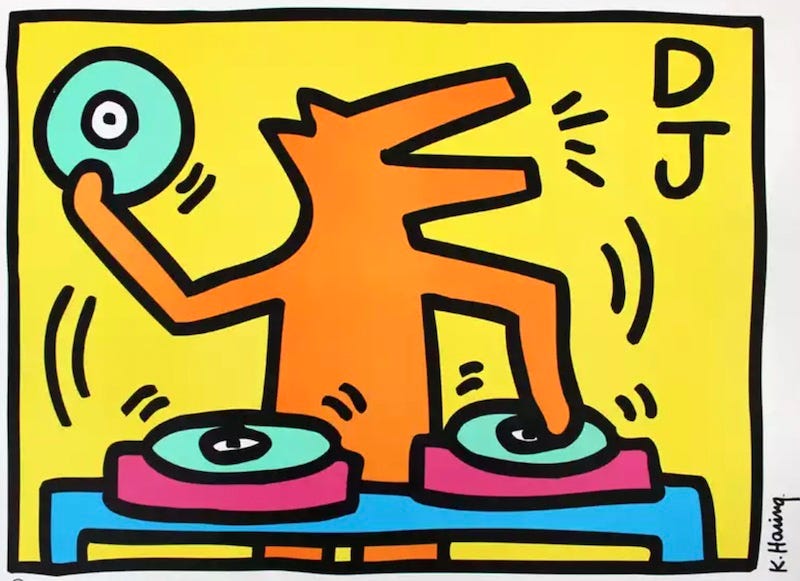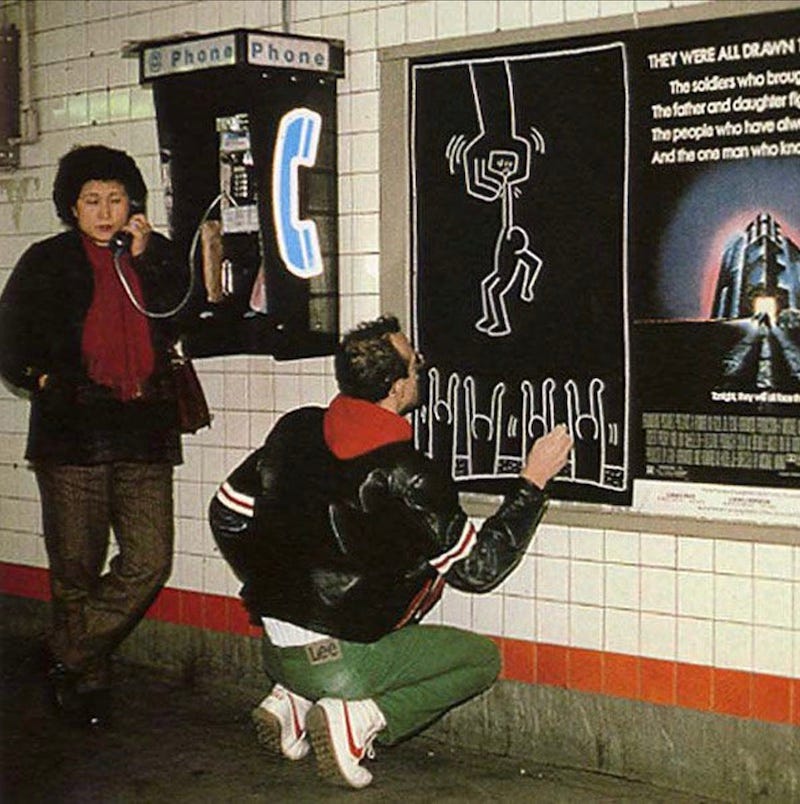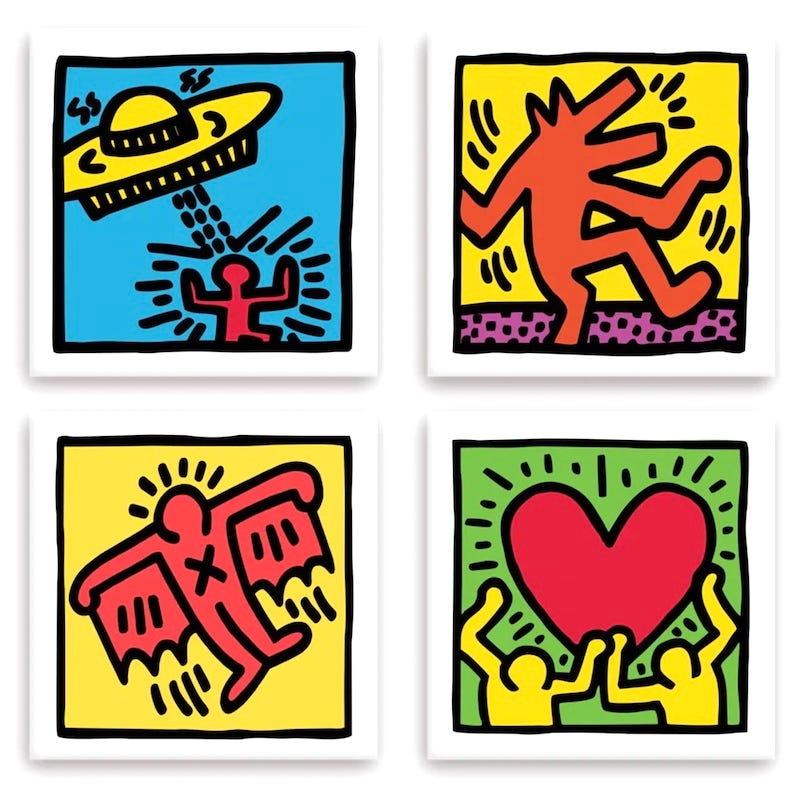One election day when I lived in Chicago, I walked over to the school by my house to vote. On my way to the converted classroom that served as the polls, I was stunned stupid by a hallway-long Keith Haring mural. The vibrant colors and simple characters are impossible to mistake for anyone else’s work. Haring is one of my all-time favorite artists, and I had no idea that one of his last murals was only a few blocks from my house. During my undergraduate studies, my last big paper in English Composition 102 was a biography of Haring. He passed away as I was writing it.

As an advocate and an artist, Haring occupied a unique place in the world. He skirted the aesthetics of typical graffiti by drawing thick-lined stick-figure characters and animals dancing and moving, the lines as flexible as their fancies. “Haring demonstrated that one could create art on the street that differed from the more pervasive lettering-based graffiti,” writes my friend and Obey Giant artist Shepard Fairey in the Foreword to Haring’s Journals. “He also showed me that the same artists could not only affect people on the streets, they could also put their art on T-shirts and record covers, as well as have their work respected, displayed, and sold as fine art.” Whereas most graffiti looks like graffiti—that is, it embodies its own aesthetic, much in the way tattoos do—Haring’s was more whimsical, like children’s hieroglyphs, if the children understood the many facets of line, its limits, and its capacity to communicate.
“Your line is your personality.” — Keith Haring
We love to hear the story about how artists live and worry. Graffiti proper, in the modern sense of the term, started in the late 1960s in New York City when a kid from the Washington Heights section of Manhattan known as Taki 183 (“Taki” being his tag name and “183” being the street he lived on) emblazoned his tag all over NYC. He worked as a messenger and traveled all five boroughs via the subways. As such, he was the first “All-City” tagger. Impressed by his ubiquity and subsequent notoriety, many kids followed and graffiti eventually became a widespread renegade art form. Aerosol artists embellished their names with colors, arrows, 3-D effects and wild lettering styles.
By the mid-to-late 1970s, New York—especially its subway system—was covered with brightly colored murals with not only tag names, but holiday messages, anti establishment slogans and full-on art works known as “pieces” (short for “masterpieces”). The world of graffiti preceded the rest of hip-hop culture, but became an integral part during hip hop’s early-1980s boom, joining breakdancing, emceeing and DJing as hip-hop’s four elements.

After filling fifty bags with garbage, cleaning up the three-foot-high garbage piles obscuring an abandoned handball wall on the corner of East Houston Street and the Bowery in the East Village, Haring and his partner, Juan Dubose, painted a giant mural of his signature figures breakdancing, running, and spinning in bold, fluorescent colors. Like many other graffiti artists replacing the drab city walls and boring metal subway trains with greetings and flashy colors, Haring saw himself as doing a service to the city. City officials and stuffy citizens hardly agreed. Massive anti-graffiti campaigns grew right along with the art form itself and are still in effect today in most major metropolitan areas. These specialized anti-graffiti forces only added to the art form’s already outlawed status. The ability to pull off a hype piece under such increasing pressure only made great writers more revered for their skills.
Haring started his public-art practice using chalk on empty ad panels in the New York subway stations. In spaces usually reserved for advertising, Haring drew alien abductions, mushroom clouds, radiant babies, barking dogs, televisions, and people, people, people. Between 1980 and 1985, he sometimes produced upward of forty drawings a day. This practice eventually gave way to murals and other more colorful paintings. His simple designs, characters, and animals caught on, even with a graffiti-weary public, leading to gallery shows and commercial work.

In spite of criticisms about the latter, his art never lacked bite. His images pushed back against everything from apartheid in South Africa and the threat of nuclear weapons, to the epidemics of crack and AIDS. These works appeared not only in chalk on black paper ad blocks but printed on posters, wheat-pasted on poles, and buttons on the lapels of friends and strangers. So prolific was his artistic protest and promotion that he drew the envy of no less a contemporary than Andy Warhol. “He was jealous of how Keith was like an advertising agency unto himself,” said the photographer Christopher Makos. “That was the cleverest thing any artist at the moment was doing.”
Companies develop—or hire other companies to develop—brand identities and campaigns. Logos, slogans, and thematic series of ads combine to sell products, brand recognition, and brand loyalty. Like the best branding, graffiti tags have to be catchy, and they have to have good letters or great characters. Graffiti and its corporate sanctioned sister art, advertising, are our modern day cave paintings. As Marshall McLuhan put it, “ads are not intended to be seen but to produce an effect. The cave paintings were carefully hidden. They were a magic form, intended to affect events at a distance.”
The artist Yasiin Bey once called hip-hop a folk art. It’s art by the people, for the people, and provides some use outside of mere decoration. “Art is nothing if you don’t reach every segment of the people,” Haring once said. “The performative nature of drawing for him was very important,” said his dealer Tony Shafrazi, describing a scene where Haring had run into a group of young people at a coffeeshop and drew pictures and gave them away. “That form of producing and giving was beyond any form of management. He had to let it flow. He couldn’t limit it.” Haring wrote the following in his journal on March 18, 1982:
My contribution to the world is my ability to draw. I will draw as much as I can for as many people for as long as I can. Drawing is still basically the same as it has been since prehistoric times. It brings together man and the world. It lives through magic.

Keith Haring passed away on February 16, 1990 due to complications from AIDS, yet his work is more widespread now and as recognizable as ever, still celebrating simple, innocent notions like spontaneity, generosity, and a love of humanity. As I mentioned above, I was writing an English Composition paper about him when he died, but I currently have a pair of socks with his drawings on them. His work is timeless.
And traditional graffiti still thrives in cities and along major train lines. It has survived as what the punk-intellectual Jello Biafra once called “the last bastion of free speech,” and the yippie Abbie Hoffman called it “one of the best forms of free communication.” Anyone can grab a can of spray paint, a fat marker, or some chalk and make their thoughts known to the passing population. You can buff graffiti, you can paint over it and you can arrest its practitioners, but as long as someone feels that their voice isn’t being heard, you can’t make it go away.
This post is part of a loose trilogy:

